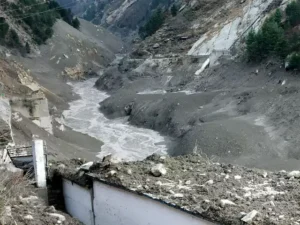
Why in news?
- The Uttarakhand government’s initiative to assess the risk of Glacial Lake Outburst Floods (GLOFs) reflects the growing concern over the potential catastrophic events in the Himalayan region.
- With the threat of climate change exacerbating glacial melting, understanding GLOFs becomes imperative for disaster preparedness and mitigation efforts.
Glacial Lake Outburst Floods : Nature and Causes
- Glacial Lake Outburst Floods are sudden and devastating events triggered by the rapid discharge of water from glacial lakes.
- As glaciers retreat, meltwater accumulates in depressions, forming lakes dammed by unstable ice or sediment.
- Factors such as glacial calving, avalanches, or landslides can lead to the breach of these dams, releasing torrents of water downstream.
Rising Risks in Uttarakhand
- Uttarakhand, with its vulnerable terrain and glacial lakes, faces significant risks from Glacial Lake Outburst Floods.
- Recent events, including the 2013 disaster in the Kedarnath valley and the 2021 Chamoli flash floods, underscore the urgency of assessing and mitigating these risks.
- The state’s 13 identified glacial lakes, particularly those categorized as ‘A’ risk level, demand immediate attention due to their potential for catastrophic flooding.
National and Global Concerns
- The National Disaster Management Authority (NDMA) has identified 188 glacial lakes in the Himalayan states as potential GLOF hazards, emphasizing the need for proactive risk assessment and mitigation measures.
- Globally, studies indicate that millions of lives and crucial infrastructure are at risk from GLOFs, highlighting the urgency of collaborative efforts to address this looming threat.
Uttarakhand’s Preparedness Initiatives
- The Uttarakhand government’s decision to evaluate the risk of Glacial Lake Outburst Floods demonstrates a proactive approach to disaster management.
- By categorizing glacial lakes based on their risk levels, the state aims to prioritize mitigation efforts and enhance early warning systems.
- Such initiatives are crucial for minimizing the loss of life and property in the event of a GLOF incident.
Climate Change and Future Challenges
- The escalating risks of Glacial Lake Outburst Floods in Uttarakhand are compounded by the effects of climate change. Rising temperatures are accelerating glacial melting, exacerbating the threat of GLOFs in the region.
- A projected increase in average maximum temperatures further underscores the need for adaptive measures to mitigate the impact of GLOFs on vulnerable communities.
Conclusion:
- As Uttarakhand grapples with the dual challenges of climate change and glacial lake hazards, proactive measures are essential to safeguard lives and livelihoods.
- By prioritizing risk assessment, early warning systems, and community preparedness, the state can mitigate the impact of GLOFs and build resilience against future disasters.
- Collaborative efforts at the national and global levels are imperative to address the complex interplay of climate change and glacial dynamics, ensuring a safer and more sustainable future for all.
People also ask
Q1: What are Glacial Lake Outburst Floods (GLOFs)?
Ans: GLOFs are sudden and catastrophic events triggered by the rapid release of water from glacial lakes, often caused by factors such as glacial melting, avalanches, or landslides.
Q2: Why is Uttarakhand vulnerable to GLOFs?
Ans: Uttarakhand’s rugged terrain and numerous glacial lakes make it susceptible to GLOFs. Recent events, such as the 2013 Kedarnath disaster and the 2021 Chamoli flash floods, highlight the state’s vulnerability.
Q3: How many glacial lakes are at risk in Uttarakhand?
Ans: Uttarakhand has 13 identified glacial lakes prone to GLOFs, with five lakes classified as high-risk (‘A’ category). These lakes pose significant threats to downstream communities and infrastructure.
Q4: What are the potential consequences of GLOFs in Uttarakhand?
Ans: GLOFs can lead to devastating floods, submerging valleys, damaging infrastructure, and causing loss of life and livelihoods. The impacts can be severe and far-reaching, affecting communities downstream.
Q5: What initiatives has the Uttarakhand government undertaken to address GLOF risks?
Ans: The Uttarakhand government has formed expert teams to assess the risk of GLOFs in the region. By categorizing glacial lakes based on their risk levels, the state aims to prioritize mitigation efforts and enhance early warning systems.
Thanks for sharing. I read many of your blog posts, cool, your blog is very good.
Your article helped me a lot, is there any more related content? Thanks!